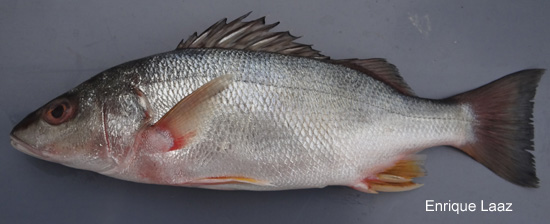| SOURCE FOR OCCURRENCE IN ECUADOR: This species occurs in coastal rivers throughout the area (e.g. Barriga, 1991; Barriga, 1994; McKay and Schneider, 1995; Bussing, 1998). |
| ORIGINAL DESCRIPTION: Jordan, D.S. and B.W. Evermann. 1898. The fishes of North and Middle America: a descriptive catalogue of the species of fish-like vertebrates found in the waters of North America, north of the Isthmus of Panama. Part II. Bulletin of the United States National Museum No. 47: i-xxx + 1241-2183. |
| TYPE SPECIMENS: |
| TAXONOMIC STATUS: Valid (Eschmeyer and Fricke, 2012). |
| RANGE ECUADOR: Coastal rivers of western Ecuador (McKay and Schneider, 1995). |
| RANGE OUTSIDE OF ECUADOR: Baja California to Peru (McKay and Schneider, 1995). |
| COLLECTIONS IN ECUADOR: |
| MAXIMUM SIZE: Approximately 36 cm total length (McKay and Schneider, 1995). |
| DISTINGUISHING FEATURES: This is a freshwater haemulid. Haemulids are common in marine and estuartine waters. Therefore, this species is quite distinctive in freshwater habitats. As a perciform, this species has strong spines in the first dorsal fin and the anal fin. The anal fin has three spines and seven rays. The second spine is much longer and thicker than the third spine. The body is oblong and moderately compressed. The preoperculum is finely serrated. |
| ECOLOGY: Pomadasys bayanus is known in Ecuador as the “cabeza dura or boquimorado”. It is a large, ecologically important omnivorous fish that feeds on fishes, crustaceans, and shrimp in the genus Macrobrachium (Bussing, 1998). It occurs in rivers and streams from close to the mouth up to 640 m of altitude and does not appear to occur in estuarine or ocean waters (McKay and Schneider, 1995; Bussing, 1998). |
| ECONOMIC IMPORTANCE: This species is locally exploited as a food fish. |
| CONSERVATION STATUS: NA, although it is exploited as a food fish. |
| LINK TO FISHBASE PAGE: Click here for link |
| SPECIES PROFILE CREATED BY: Enrique Laaz |
| SPECIES PROFILE CONTRIBUTORS: Windsor Aguirre |
